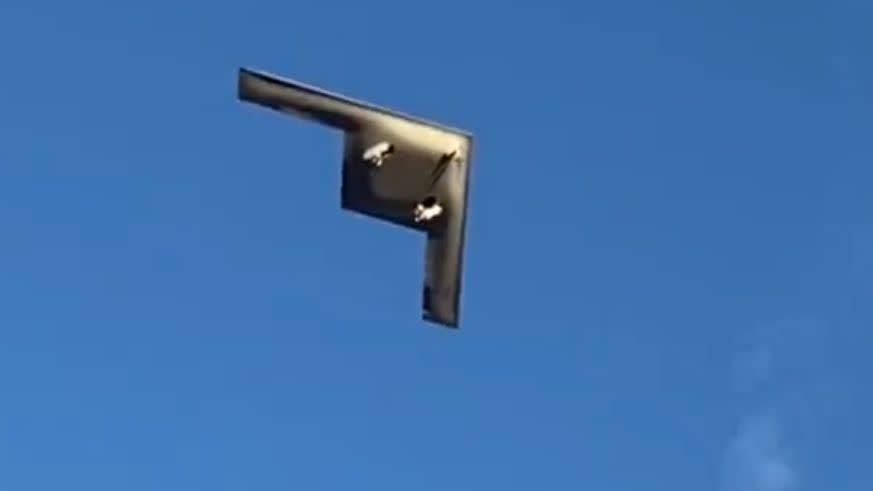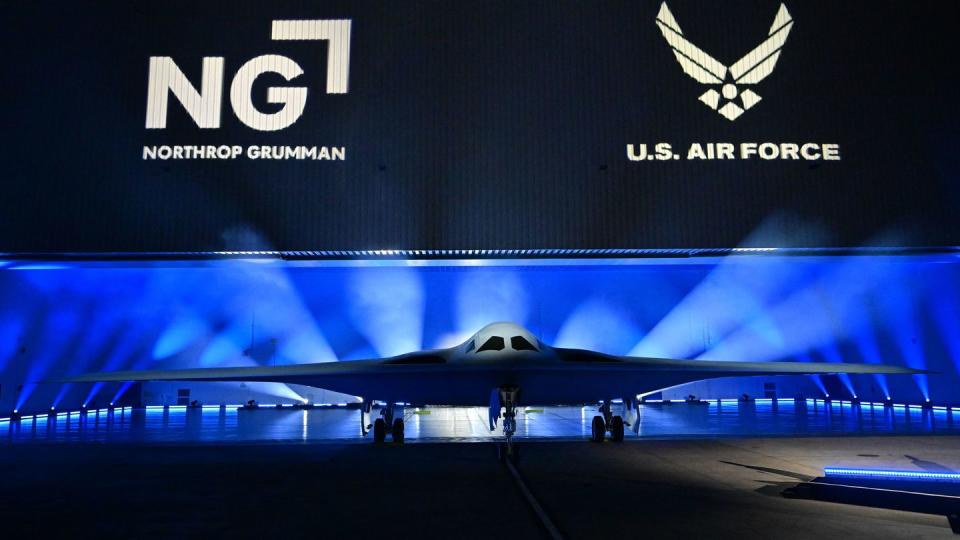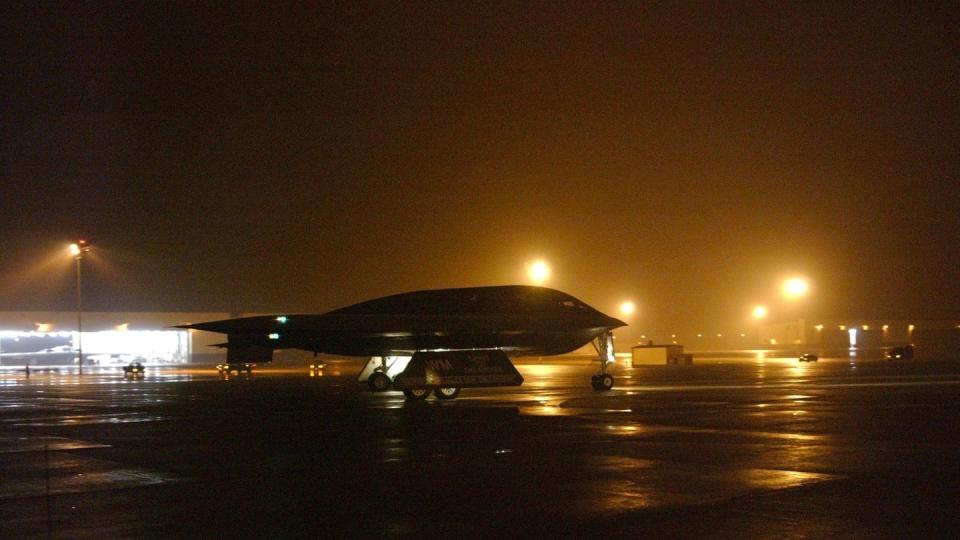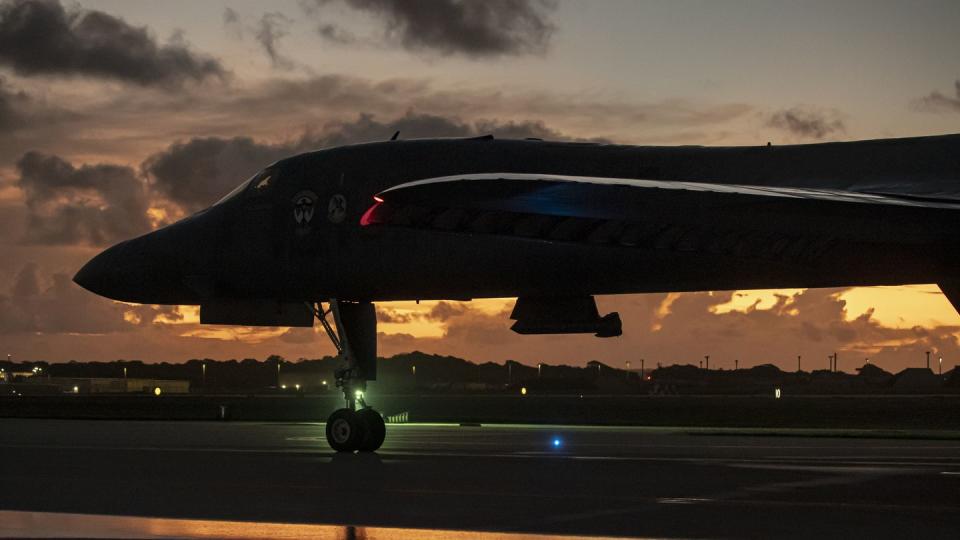The Air Force's B-21 Raider Stealth Bomber Has Taken Its First Flight

At 6:51 a.m. on Friday, November 9, the U.S. Air Force's advanced new flying-wing B-21 Raider stealth bomber lifted off the ground for the first time.
B-21 RAIDER FIRST FLIGHT 11-10-23 #RAIDER33 #B21Raider pic.twitter.com/3tEKudqDiw
— Matt Hartman (@ShorealoneFilms) November 10, 2023
Ever since the Pentagon awarded a contract for a ‘Long Range Strategic Bomber’ to Northrop Grumman in 2015, workers at the secretive Air Force-owned Plant 42 facility in the Mojave Desert have been quietly building six prototype stealth bombers intended to enable the Air Force to deliver both nuclear and conventional attacks across the globe. The lead aircraft was finally unveiled to the public on December 2, 2022, revealing a flying wing profile similar to the B-2 Spirit bomber it’s meant to replace.

Now, less than a year later, the Raider has taken flight for the very first time. Photos and video footage posted by freelance aviation photographer Matt Hartman show the stealth bomber flying near Plant 42 on Friday with an escorting F-16 flying at its side.
#BREAKING
B-21 RAIDER FIRST FLIGHT #RAIDER33 #B21Raider 11-10-23 pic.twitter.com/G8dr87bAa4— Matt Hartman (@ShorealoneFilms) November 10, 2023
The bomber's three 'tricycle' two-wheel landing gears are lowered, with two hexagonal landing gear bay doors open under the fuselage, and one arrow-shaped door under the nose. An orange-painted pitot tube was visibly mounted left of the nose gear for gathering air speed and air pressure data for flight tests.
Air Force spokeswoman Ann Stefanek subsequently confirmed to multiple media outlets that the B-21 “is in flight testing."
The Raider is a subsonic bomber with a crew of two and large internal fuel capacity, which would be extended routinely by in-flight refueling for intercontinental-range missions. The Raider was intended to be optionally capable of uncrewed operations as a drone, but now, it seems that functionality will be phased in later than manned operations (if it ever is).
Somewhat smaller and with a ‘cleaner’ rear-aspect than the B-2, the B-21 is believed to have an even smaller radar cross-section and be optimized for higher altitude operations as hinted by its lighter-colored camouflage scheme. The Raider is designed for all-aspect stealth from any angle so it can penetrate deep into hostile airspace and remain difficult to detect by radar from the side and behind—not just when scanned from the front. Its stealth is also purportedly effective against both high-band targeting radars and low-band radars that sometimes are sometimes able to detect activity of non-flying-wing stealth fighters.
The exterior is continuously curved, with all leading edges swept at the same angle (including hatches).
The bomb bay is the only flat surface (and this may have a gentle curve we cannot see in this lighting).
This is mathematically a nightmare for radars. 🤘 pic.twitter.com/fvQWaqHCOu— Jon Harper (inactive) (@jonspaceharper) November 10, 2023
Since its unveiling, the B-21 team had been steadily working up to the first flight of the lead aircraft, starting with the first power-up of the aircraft’s systems, and in September, static tests of its turbofan engines, which are based on F135 engine used by F-35 stealth fighters. Finally, the B-21 was seen rolling along the runway in taxi tests late in October, which typically herald an imminent first flight.
Following the first flight in November, the B-21 will eventually fly to Edwards Air Force Base (just 12 miles away) where it will continue sustained flight tests conducted by the 412th Test Wing as part of the engineering and manufacturing development (EMD) phase.
Should testing proceed on schedule—not something one should take for granted—the Raider may enter production and operational service in the mid-2020s, gradually replacing by 2040 the Air Force’s 20 B-2 Spirit stealth bombers and 45 B-1 Lancer supersonic bombers. However, around 75 older, but more cost-efficient B-52 bombers will remain to serve as missile trucks carrying long-distance missiles.

Chronologically, the B-21 will debut in service at Ellsworth Air Force base in South Dakota, home to the 28th Bomb Wing (a B-1 unit); then Whiteman Air Force Base in Missouri, home to 509th Bomb Wing, the Air Force’s only B-2 wing; and finally Dyess Air Force Base in Texas, home to 7th Bomb Wing, the service’s other B-1 wing.
The B-21 plays a central role to the Pentagon’s plans to maintain an edge over Russia and China despite their development of advanced air defense and land-attack missiles. And accordingly, it will be costly, estimated at $692 million per plane in 2022 dollars.
To be fair, that’s significantly less than the B-2 the Raider is meant to replace once you factor in inflation; and the B-21 is designed to be much less expensive to maintain and operate. Despite some delays, development of the B-21 has proceeded with far less drama, delays and cost overruns than notoriously afflicted the F-35 stealth jet and B-2 Spirit.
Admittedly, operating costs ultimately outstrip procurement costs, and by that metric, the minimum fleet of 100 B-21 Raiders is projected to cost $203 billion to procure and sustain over 30 years. Air Force officials, however, have repeatedly stated they see a need for 145-175 B-21s, and some hawks argue a fleet size exceeding 200 is warranted.
Why the Raider isn’t just a nuclear bomber
The Raider is making its first flight at a time in which much (arguably, most) of the existing arms control regime between the U.S. and Russia of the last four decades has evaporated, a large-scale land war rages in Europe due to an unprovoked invasion by Moscow, and tensions with China are high as it expands its historically much smaller nuclear arsenal and mulls the possibility of an invasion of Taiwan.
These all make the B-21’s high-end warfighting capabilities seem distinctly more relevant today than a decade ago, when the Pentagon’s day-to-day operations were often preoccupied with fighting insurgents in the Middle East and Afghanistan.
Of course, the B-21’s application as a nuclear bomber will receive much scrutiny, wherein it’s considered a component of a broader Long Range Strike system also including the AGM-181 LRSO stealth nuclear cruise missile, and the shadowy RQ-180 long-range stealth drone (which allegedly shares the B-2 and B-21’s flying wing profile).
But the Air Force plans to use the B-21 in wider range of roles, and more extensively for conventional warfare, than it has with its small B-2 fleet. That flexibility will be facilitated by open-architecture computers allowing easier integration of new capabilities (weapons, jammers, sensors, etc.) without requiring depot-level block modernizations—supposedly in one-tenth the time needed for a B-2 according to an Air Force general.
While the Pentagon is procuring many small, short-range F-35 stealth jets, it sees many uses for a platform that is both stealthy (and thus can operate relatively safely close to enemy air defense and fighters) and can still fly very far, for many hours carrying a potentially large payload. That’s in part because of fears the airfields and carrier decks relied upon by short-range stealth fighters may be over-exposed to strikes by cruise and ballistic missiles, particularly those amassed by China. A B-21, however, could conduct missions from more distant, safer bases in Hawaii or Diego Garcia, or even the continental United States (though with reduced efficiency).

In a non-nuclear conflict over Taiwan, for example, one of the B-21’s chief missions would likely involve locating and sinking invasion ships. The Air Force has also suggested it expects the B-21 to serve as a forward reconnaissance and battle command post managing operations and attacks by other aircraft including those of other countries, and combat drones controlled via the B-21 itself, which could presumably undertake riskier missions than manned aircraft.
In a sense, that means Raiders could serve as vastly more survivable alternatives to airliner-based E-3 and E-7 airborne early-warning jets, recently retired E-8 JSTARS command posts, and RC-135 reconnaissance jets, none of which can approach hostile modern air defenses and fighters with much safety.
But translating these ambitious new operating concepts into reality must await another day. For now, the B-21’s first flight heralds many more months of testing to ensure the Raider flies as safely and reliably as predicted by computer models, discover whatever unexpected kinks inevitably crop up and devise solutions to them. This process can sometimes involves substantial unexpected delays, as happen with Boeing’s T-7 Red Hawk jet trainers due to unsatisfactory ejection seat trials prior to flight testing.
A tailless flying wing design like the B-21 requires particularly extensive intervention from its fly-by-wire flight control computer for stable flight—corrections that typically receive fine-tuning and iteration based on flight tests. Thus, much work lies ahead as test pilots gradually put the lead Raider—and eventually its five sister aircraft) through its paces and figure out necessary modifications to software (ideally!) or hardware, paving the way for additional Raiders to be built in the low-rate initial production phase.
How smoothly that process goes may affect how many Raiders Congress ultimately chooses to buy. Regardless, the newly airborne Raider seems on track to occupy a major role in U.S. national security strategy for decades to come.
You Might Also Like
